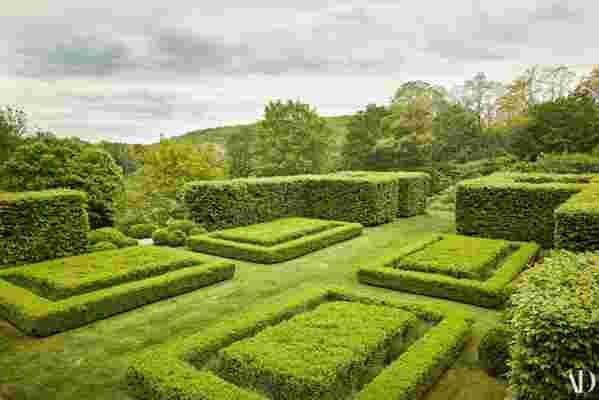"I never thought a garden would be part of my life,” the AD100 architect and interior designer Daniel Romualdez says about his weekend home in north-west Connecticut. “I have no skills with gardening, no landscape vision,” he adds modestly. But ten years ago Romualdez asked his friend the landscape designer Miranda Brooks to make something of the property around the 18th-century house he had recently purchased, where he and his husband, investment banker Michael Meaghar, planned to spend fall, winter, and early spring. Once famously the home of fashion great Bill Blass, the handsome fieldstone-and-clapboard house had become shrouded with overgrown rhododendrons, the sky darkened by towering conifers. No design of the outdoors had ever been undertaken. There was no view, no place outside to sit. Brooks changed all that.
“It was exciting making a winter garden,” Brooks says, concentrating on green architecture and perspectives, on the forms of trees and shrubs, planting roses more for their colorful hips through fall and winter than for their flowers. But what she proposed was a huge project. Construction ensued, as major walls were built and grades were changed to conquer a dramatic descent on the south side of the house and allow for a series of garden spaces. Steps now lead down from the south-facing sunroom to a terrace laid randomly with granite slabs and planted lushly with box bushes, amsonias, grasses, Japanese anemones, peonies, and lilacs around a cluster of garden chairs. More comfortable seating and a dining table are shaded by a bamboo-covered pergola at the end of the terrace.

A formal Hornbeam-enclosed parterre of boxwood interplanted with Moorhexe grass sits below the house and stone terrace. Old trees and wilder meadows lie just beyond.
Pots of rosemary and figs mark steps descending to a formal garden space enclosed by tall hornbeam hedges. Four bold box parterres are centered here in an expanse of lawn and simply filled almost to the edges with more boxwood, clipped slightly higher. The gaps between the inner boxwood and the outer are filled with a grass, Molinia caerulea—moorhexe—that waves above the parterres, seemingly laughing at the stolid blocks of green. The journey continues past these strict hedges and opens out onto a pastoral scene of high grass and fruiting trees, an old apple orchard threaded with paths on one side, woods and blue hills beyond. Romualdez wanted a focal point that he could see from the house in winter, and that led to the construction of a folly—a stone pyramid at the end of an allée carved out of the woods.


Walking back from the pyramid, you glimpse the white steeple of a church rising above the garden.Brooks brought an understated elegance to the north, more public side of the house. “I wanted to make the front supersimple,” she says. The façade was cleaned of old shrubbery and now is viewed from the road sitting plainly on its bed of lawn, ledge rocks, and ferns, shaded by ancient sugar maples. “I’m an architect and want to see the house,” Romualdez says. Brooks redirected the entrance driveway, giving it no fanfare—no stone posts, no gates, no lampposts. Now it’s merely two strips of gravel set in lawn, but placed charmingly on axis with the 19th-century stone church across the street. Pleached lindens enclose the small parking area that leads to the front door of the house.
After Miranda did the garden, I really felt like I was in the country. I'm in love.
Romualdez says what appeals to him about Brooks’s gardens is that there’s strict architecture and yet “she knows when to let go. Miranda also knows how people live and how to help them to live better,” he notes, referring to the sitting areas she carved out below the house. “We love to read in the garden.” Romualdez spends many hours beneath the pergola, “lunch, after lunch, dinner—it’s literally our living room.” Brooks adds, “Even in winter, Daniel is out there, covered with blankets!” From the pergola, he looks out onto the stone terrace and its plantings, and down the long view to the hills and the sky. “After Miranda did the garden, I really felt like I was in the country. I’m in love. We rush home on the weekends to see what’s new. It changed the way we live.”
